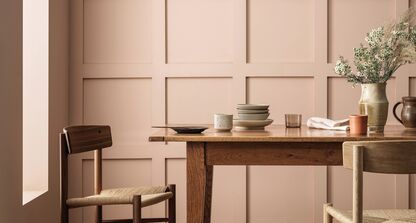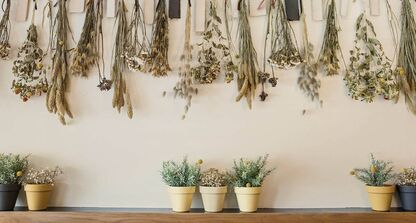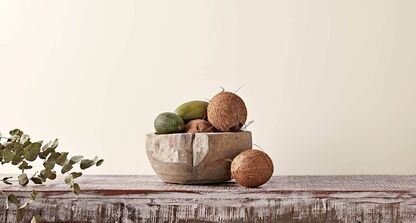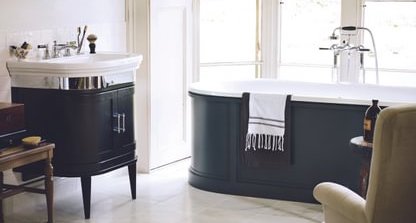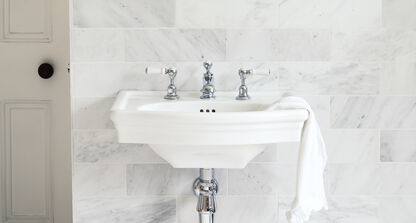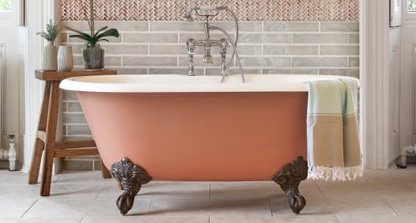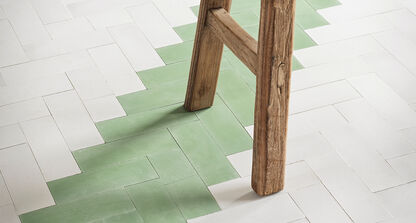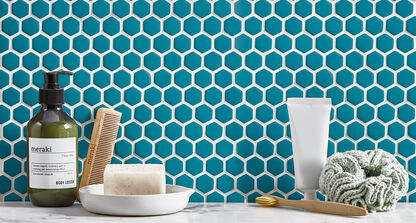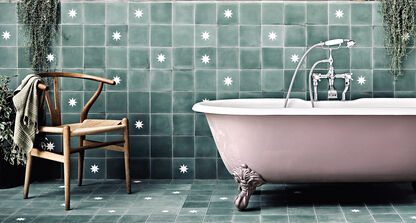How to Choose the Right Bathroom Tiles
Tiles are not just a functional element of your bathroom - they can make or break the feel of the room. Are you after a bright, modern finish? A striking and bold feature wall? They are the first thing you notice when you walk in, so it’s important to get it right.
This may sound daunting, but fear not; we’ll walk you through everything - from how to choose your bathroom tiles to how to arrange them, with added tips like how to choose tiles for small bathrooms.
Choosing the material of your bathroom tiles
It can be hard to know what type of tiles are best for bathroom walls as there is such a wide range to choose from. Truth is, it’s all about weighing up your individual needs to get the right bathroom for you. Some tiles require more maintenance than others, some are more expensive - there is no one perfect combination for all. Let’s explore the pros and cons of different materials.
Natural stone tiles
Using natural materials instantly gives your bathroom a distinct look - an element of character that is unique. Natural stone tiles can also come in further varieties including:
- Limestone - can come in both lighter and darker tones; a softer type of stone
- Marble - with its vein pattern, it is a sophisticated stone that gives an opulent feel
- Slate - offers a darker tone; quite striking and can also be used on the floor for greater grip
- Travertine - comes in warm tones and has natural pits that make each tile individual
However, natural stone requires a lot of extra maintenance. They need to be resealed frequently to protect the tiles and they can potentially get scratched or worn more easily.
Man-made tiles
These are often a cheaper alternative to natural stone tiles and are more hard-wearing with less maintenance. Although they don’t have the rustic and traditional look, they offer a wide selection of aesthetics so you can create just about any bathroom design you can think of.
- Porcelain - these are extremely dense so are one of the most hard-wearing tiles available
- Ceramic - highly affordable and easy to look after; not as durable as porcelain
- Gloss - easy to clean and reflect light, so can make the space feel brighter
- Matt - don’t reveal watermarks as easily and can also mimic other materials (including stone) for a ‘cheat’ way of getting the natural look you want without the high maintenance
How to choose bathroom tile colours
The colour of your tiles often dictates the feel of a room. Whether you want it to be light and open, cosy or bold - it’s all in the colour. Although lighter colours can often make a space feel bigger, don’t be afraid to add some contrast with different colours and patterns to make a room more interesting and stimulating.
You can start with a stand-out colour - use this as your base colour or even create a feature wall with it. If you are only going with a bold colour choice, then you should really only have one. Otherwise, the room has too many focal points and the next thing you know, your bathroom has turned into the next modern art collection from the Tate Modern!
To compliment your choice of colour, it's a good idea to pick one or two accent colours. Opting for accent colours that are more neutral will help make your chosen colour stand out more. The aim is to tie it in for a cohesive theme, drawing your attention to the main colour rather than distracting the look with too many colours
Tiles for small bathrooms
You may be guilty of thinking this already, but the size of the bathroom shouldn’t determine the size of the tiles you choose. A large tile size in a small space can actually give the illusion of a larger space because there are fewer grout lines cluttering the walls.
The main trick is using light-reflective tiles. A gloss finish can brighten and enhance a small space, just from a simple illusion. This can be paired with a lighter tile colour, although it doesn’t have to be - just don’t use all-black tiles!
Using the same pale colourway tile on both the bathroom walls and floor can be another tactic to create further depth to a room. It plays on the reflection of light again, creating a sophisticated look. Or, if you want to avoid using the same tiles because you prefer something a bit more visually interesting, use a mosaic or pattern to create dimension and enrich the space.
Patterns and layouts
Don’t be afraid to experiment with patterns. Patterns can be used to create a feature wall or highlight a smaller area, such as a shower wall or behind the sink. You can do this via colour, shape or even texture.
Stone tiles are well-known for their interesting texture patterns. If you are after your own personal spa then using these textures will definitely give you a spa-like feel. Contrasting these textures with smooth tiles is also another way of adding dynamics to your bathroom.
Mosaics can be used in the same way as a contrast colour. They can be quite effective as a border, adding in some variety without being overwhelming.
Practicality
Of course, you want your bathroom to look nice, but it’s also important to think of the long term practicalities of it. After all, it is a room you use every day.
Cleaning
Bathrooms have a lot of moisture and mould can become an issue. Cleaning smooth tiles is easy and practical for this matter. However, textured surfaces, particularly natural stone tiles, have a lot of crevices and gaps where water can rest. This means they require more thorough cleaning - so bear that in mind if you aren’t a fan of it!
Slip-resistance
If using tiles for the floor of your bathroom, you want it to feel nice on your feet. It may sound simple but it’s something to consider. With that in mind, you need to balance this with the slip-resistance. Smaller tiles will mean more grout lines, which will increase the slip-resistance without being too harsh on your feet. Just be wary of using heavily textured tiles on the floor because, although this creates greater resistance, it may be uncomfortable.
Choosing the right grout for your bathroom tiles
Grout doesn’t just have to be white. Although it is a very functional and important part of tiling, it can also become a decorative part too.
Use a light-coloured grout to make your bathroom look brighter, or use a darker one to really accentuate the tiles you chose. For a really modern feel, go for an energetic, bold colour - this could be an accent colour for example.
As you can see, there are a lot of choices when it comes to choosing bathroom tiles. Hopefully this has given you some bathroom tiling ideas so you can weigh up what you value most for your bathroom. We’re not saying you need to be the next Grand Designs, but use these tips to help make your bathroom look good in a way that suits you.


